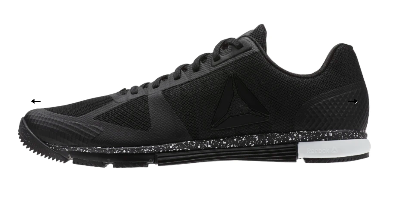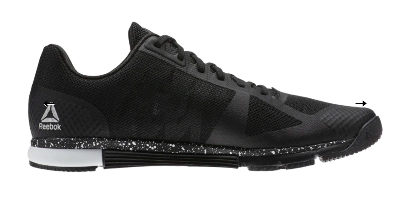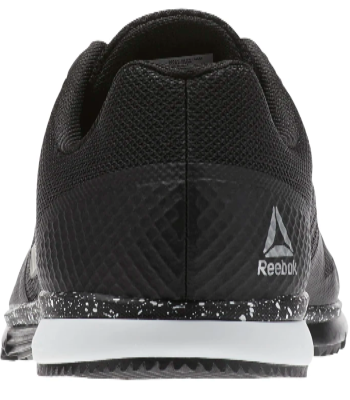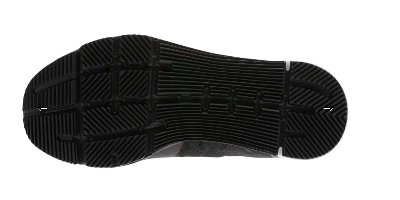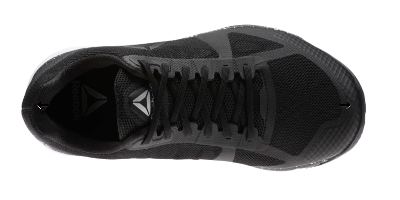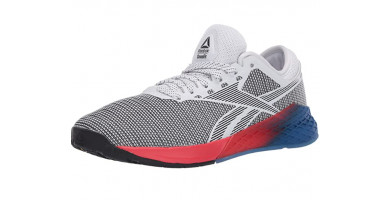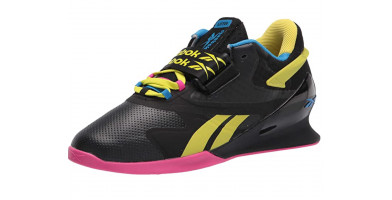Reebok Speed TR Reviewed and Rated
We reviewed the Reebok Nano 8 elsewhere on the site, and our takeaway was that it is durable, flexible, and responsive–for cross-training and especially CrossFit WOD workouts. So far, none of the shoes in the Nano line are good for running more than a fast mile or so. They do not have the support runners need to keep pounding the hard ground mile after mile.
The Speed TR aims to meet that need for runners, while also maintaining the platform you need for fast-paced group fitness classes or plyometric jumps. With the Speed TR, you can move from the gym to the track or trail without changing shoes or breaking pace.
The original Reebok Speed TR, with the Cordura upper, was released in 2018. It won an award from Shape magazine. Reebok soon updated the shoe with a proprietary Flexweave upper, making it even more flexible and adding strength to prevent wear and damage during activities that involve flexing the feet. The price for either shoe is comparable to the Nano 8, though the original Cordura upper will run you a little less. We have broken down the features, pros and cons, and bonus perks for both versions of the Speed TR.
The shoe is flexible while also providing a stable foundation for lifts and other exercises
Fit is true to size, with comfortable wear even for extended periods
Flexweave version is especially breathable and does not let feet overheat
Heel clip gives back of feet extra protection and helps lock them in for injury prevention
Both upper materials are lightweight, so the shoe will never cause fatigue or excess heat
EVA midsole helps absorb shock for an obstacle-free ride
Extra traction on both the outsole and the sides of the midsole, to help with grip
Neoprene collar on ankle cuff can sometimes cause heat in that area
The shoe may be too flexible for cross-training, as a concession to runners
The Rundown
If you do lateral exercises, such as band walks, side to side lunges, or certain step aerobics moves, you will notice how the collar and upper do not rub or chafe against your feet. That chafing can be a problem, even when you wear good socks for indoor gym workouts. The Reebok Speed TR eliminates that problem with its stitching, fabric, and low profile. The synthetic uppers are breathable, flexible, and stain-resistant, so even the white version will be easy to keep clean. This is true of both upper materials, the Cordura and the Flexweave.
By the way, you may be wondering--what are Cordura and Flexweave, and how are they different from each other? Of the two, Cordura is an older technology. Invented by DuPont scientists in 1929, Cordura is nylon or, sometimes, cotton blend fabric used in luggage, clothing, uniforms, and, of course, performance sneakers. Cordura is so durable and flexible that, in the mid-20th century, it was used as a component in automobile tires.
Flexweave is a far newer technology. Reebok introduced the fabric in 2018, and many commentators called it the future of athletic shoes. It is made from chenille fabric. The key is the stitching design, which uses a figure 8 pattern rather than the typical horizontal or vertical seams in textiles. The figure 8 pattern gives the Flexweave its strength, while also keeping it flexible and durable. As more and various types of fabrics are added, the Flexweave mesh becomes even stronger while also supporting and conforming to the shape of the human foot. Not just a gimmick, the Flexweave upgrade actually added value to the already exceptional Speed TR.
Comfort/Construction
The benefits to you include extra traction on the soles, in the form of deep flex grooves which also keep the soles from being too stiff. The Flexweave, especially, will give you traction if you go for rope climbs, without tearing or abrading the mesh uppers. The friction-free ankle cuffs and light, sweat abating mesh outer fabric will keep you moving during wind sprints or, if you are inclined, protect your ankles while you pull a sled loaded with a bumper or iron plates. The Reebok Speed TR is a performance trainer that everyday athletes can afford and enjoy.
Who It Is For
But the shoe is not only for CrossFitters. It is a cross-training shoe, offering stability and rigidity, but also something runners can wear during their excursions. The Reebok Speed TR meets gym devotees and runners each halfway, with both a firm platform and more padding than a cross-trainer will typically offer. While the Nano series is almost exclusively for cross-training, the Speed TR offers something for everyone. The mesh upper, whether Flexweave or Cordura, keeps the shoe light, prevents overheating and adds to the overall durability and useful life of the shoe.
We have not touched on it much, but the Speed TR is good for lifting weights as well. it has the support, stability, and toe room you need for squats, upright rows, and EZ-curl bar curls. Even if you do bodyweight squats, with no barbell or dumbbells, the shoe's low profile ankle cuff will help ensure your range of motion. We just don't recommend the shoe for powerlifters, or anyone who drives themselves to lift heavier and heavier weights. For those pursuits, you need a shoe with a much thinner and flatter sole. The Reebok Speed TR also lacks an inner wedge for squat assistance, and a stacked heel to aid in strengthening your ankles to enforce proper form. The form is always vital in weightlifting, but it becomes much easier to injure yourself when you go for max weight. You need a shoe that will minimize the risks; the Reebok Speed TR can keep you from hyperextending your ankle, but it is not designed for the kind of foot lockdown you need when standing up and lifting as much weight as possible.
What People Are Saying
Reviewers liked the support the shoe offers but agreed it does not have so much padding that you cannot connect with the ground when you need to. There is a preference for Flexweave over Cordura since the Flexweave provides greater flexibility and just feels lighter. The only complaint we found about the Speed TR is that, for some users, the toe box is not as roomy as they would like. But this problem usually resolves itself after a 2 to 3 week breaking in period. Athletes who wore the shoe both for the gym and for outdoor runs reported good results.

